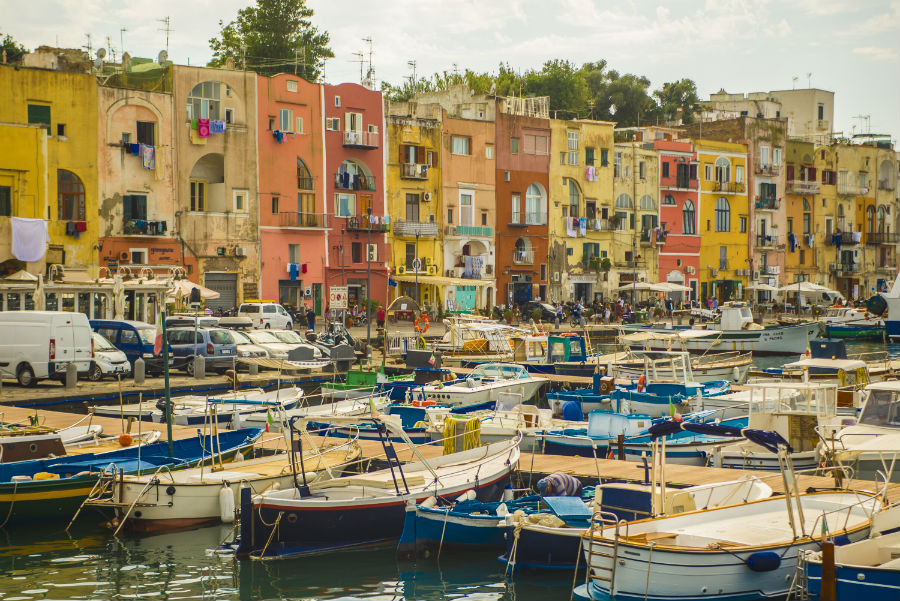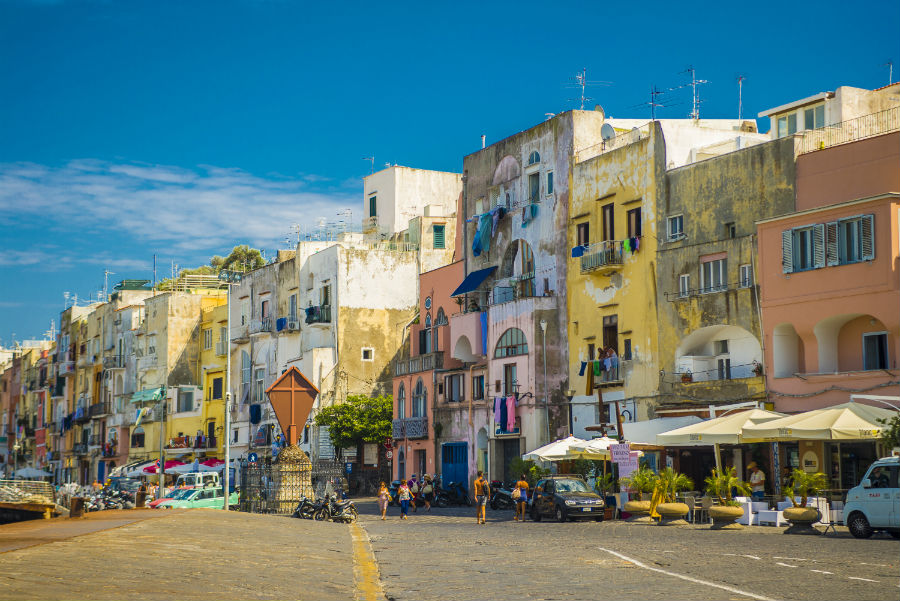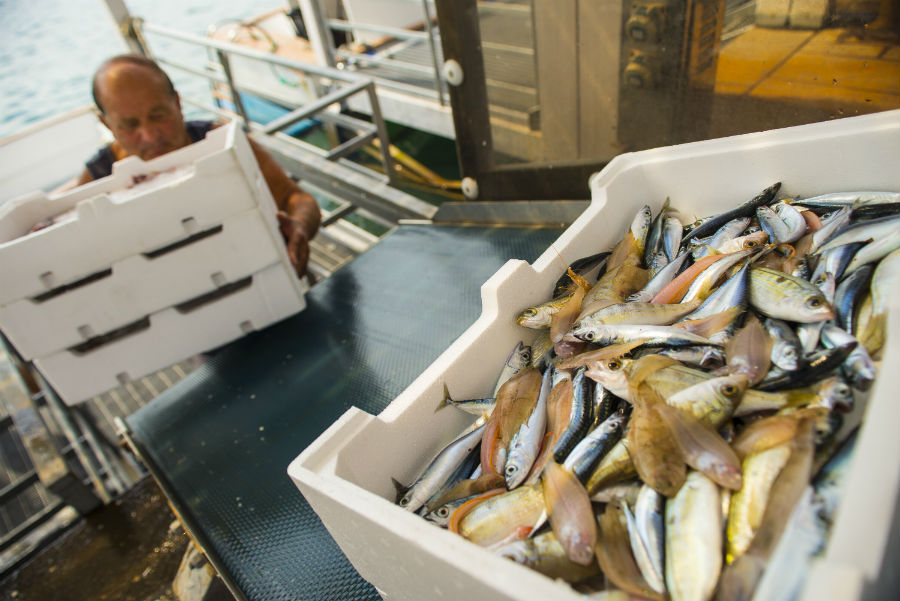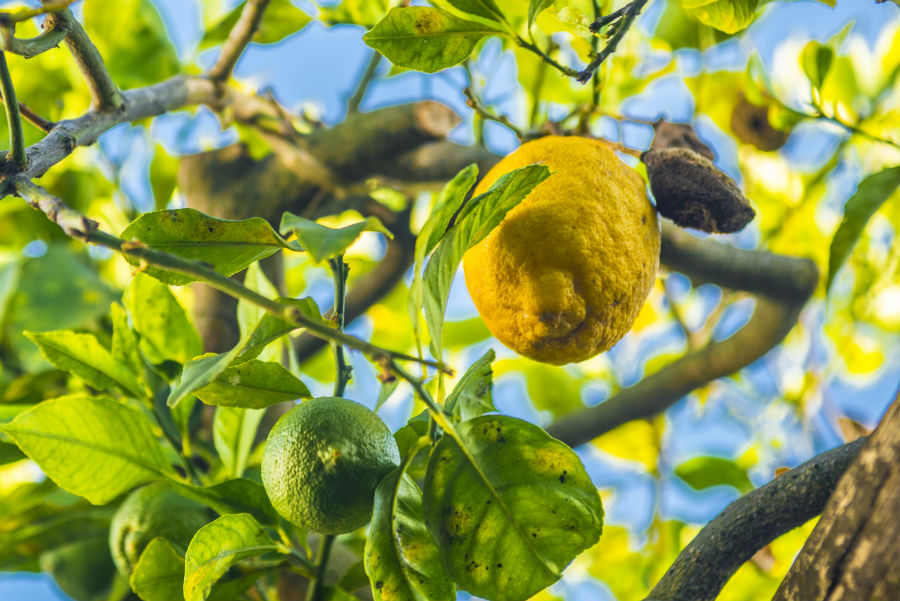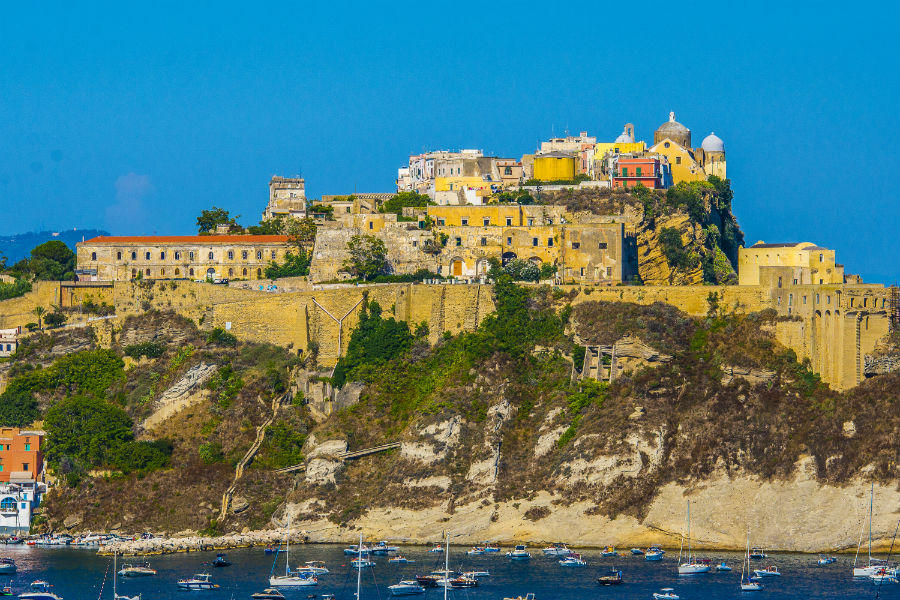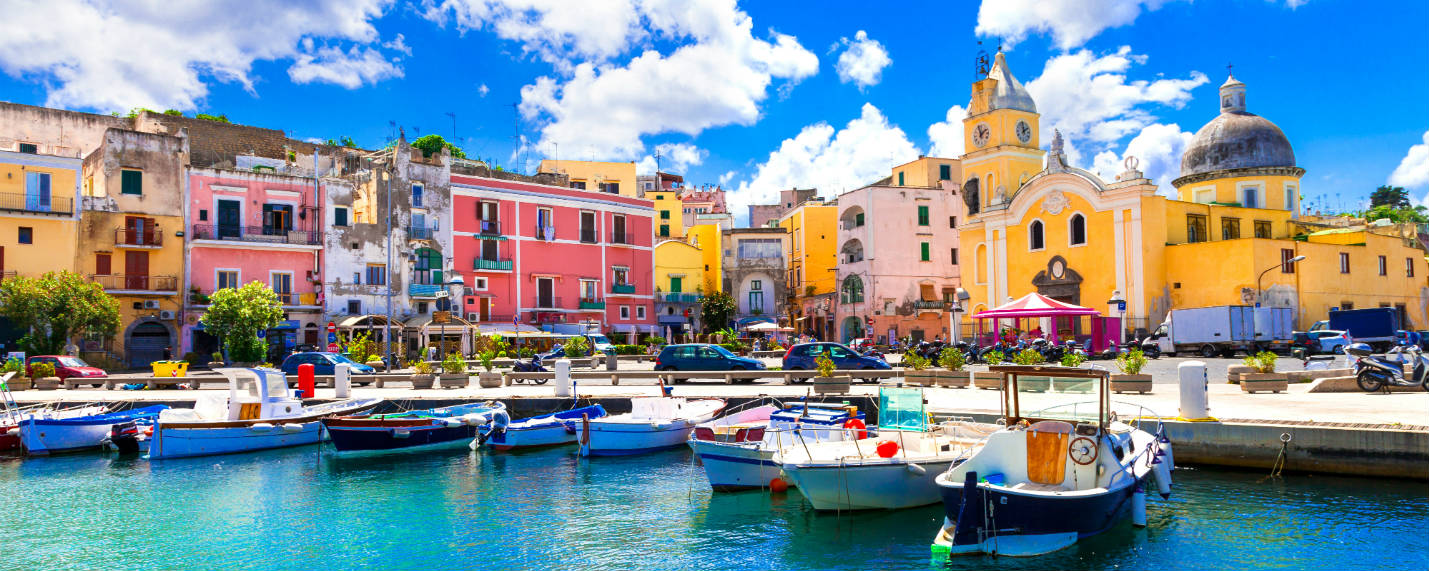Procida
- Sea village
- Suitable for disabled people
About the village
Wedged between the crystal-clear cobalt blues of the Gulf of Naples lies the splendid island of Procida, Capital of Culture 2022, an authentic pearl of rare beauty in the Campania region. The fascinating territory of Procida consists of the island of the same name and its neighboring islet, Vivara, two 18th-century gems in the enchanting setting of the Phlegrean islands.
The perfect destination for lovers of authentic experiences, picturesque Procida boasts an extraordinary variety of nooks and crannies to discover. Covered in the green of its hills, the highest of which is Terra Murata (91 m), the island is admired for the beauty of its fortified village of medieval origins that it dominates from above.
Procida's coastline, delineated by a perfect mix of sandy beaches and sheer cliffs, offers a series of bays and promontories that prove to be true corners of paradise for pleasure boating. These waves are overlooked by three marinas located on the northern, eastern and southern sides of the island, while part of the coastline is prudently preserved by the marine protected area Regno di Nettuno (Kingdom of Neptune).
Procida's authentic essence can be captured in its nine historic districts, called grancìe, each with its own character and personality: from the oldest village, Terra Murata, to the quaint fishing village, Corricella, via the lively town of Sent'cò, which houses the commercial port of Marina Grande, to the fabulous Chiaiolella and its marina on the southern part of the island.
At the heart of the island of Procida is the area of Sant'Antonio, whose epicenter is Piazza Olmo, an ideal starting point for exploring its network of alleys that branch off in every direction. From here, in fact, it is possible to walk to every corner of the island-nothing is more than 1.5 km away!
Chiaiolella, located exactly at the opposite end of the harbor, is known for its Spiaggia del Ciracciello (Ciracciello Beach), bordered by two magnificent tufa stacks, the result of the landslide of the rocky ridge that separated the two coastlines and has become the longest beach on the island. Due to its extent, the area offers both wide free beaches and tourist facilities, making it ideal for a relaxing and fun-filled vacation.
Finally, don't forget the magical Pozzo Vecchio beach, which can be reached by taking Via Cavour behind the Church of St. Anthony Abbot. This iconic beach, known for being immortalized in the film "Il Postino," offers breathtaking scenery and a dreamlike atmosphere that will make you fall in love with Procida instantly.
If you are looking for a dream retreat where you can immerse yourself in the beauty of Italian culture and nature, Procida is the dream destination for you. With its enchanting coastline, charming villages and fascinating history, this island will welcome you with open arms.
Village of Procida
Municipality of Procida
Province of Naples
Region Campania
Inhabitants: 10.496 procidani
Altitude center: 27 m a.s.l.
The Municipality is part of:
City of sea fish
Protected Natural Areas:
Natural Area Marina Protetta Kingdom of Neptune
State Natural Reserve island of Vivara
Municipality
Via Libertà 12 - Tel. 081-8109203
13.03 Kilometers from Procida
BY CAR
- From Naples: Continue the Pasquale Borelli extension, turn right on the SP193 and continue on the SP1. Continue on the A1 / E45, follow the direction to Naples and take the exit for the port. Go through Naples, get to Molo Beverello and continue by sea connection. Pass through Ischia, Casamicciola Terme and Lacco Ameno, continue on the SPEXSS270 and enter Forio.
- From Pozzuoli: Turn right on Via Comunale Tavernola and take the A56 towards Tangenziale. Take the exit towards Pozzuoli, turn right on the SP47 and cross Pozzuoli. Turn right to Largo San Paolo and take the connection by sea.
ON THE TRAIN
- Naples railway station
BY BUS
- Piazza Garibaldi station in Naples
BY PLANE
- Naples airport
BY SEA
- Beverello pier in Naples
- Port of Pozzuoli
Procida (Proceta in Neapolitan) is located in the Gulf of Naples, in Campania. The territory includes the island of Procida and the nearby islet of Vivara, two islands in the Gulf of Naples belonging to the group of Flegrean islands.
The highest relief is represented by the Terra Murata hill (91 m), dominated by a fortified village of medieval origin. The island is located at a minimum distance of 3.4 km from the mainland (Canale di Procida) and is connected by a small bridge to the nearby island of Vivara. Its coasts, in some low and sandy areas, elsewhere overlooking the sea, give life to several bays and promontories that offer shelter for small navigation and have allowed the birth of three small harbors on the northern, eastern and southern sides of the island. Much of its coastline is protected by the Kingdom of Neptune marine protected area.
Traditionally, the inhabited center is divided into nine districts, called grancìe: Terra Murata (the oldest village), Corricella (a characteristic fishing village), Sent'cò with the commercial port of Marina Grande, San Leonardo, Santissima Annunziata (also called Madonna della Libera), Sant'Antuono, Sant'Antonio and Chiaiolella (a tourist port in the southern part of the island).
Sant'Antonio is the central area of the island of Procida. The centerpiece is Piazza Olmo, a small clearing from which many small alleys branch off which lead to interesting places to visit. From here, in fact, it is possible to walk to every point of the island: nothing is more than 1 km and a half from here! Just before reaching the square, coming from the port, on via Vittorio Emanuele II it is possible to visit the Church of S. Antonio Abate. Taking the road behind the Church of S. Antonio Abate, via Cavour, going along it all, you will find yourself near the Cemetery. Wonderful to admire for its typical island architecture, next to the main entrance there is the descent to the famous and characteristic Pozzo Vecchio beach, also known as Il Postino beach.
To the right of the square, continuing in via. The current name of the island derives from that of the Roman era "Prochyta". According to a first hypothesis, this name derives from "Prima Cyme", or "close to Cuma", as the island must have seemed to the Greek colonists in the migration from the island of Ischia to Cuma. Another hypothesis makes the name derive from the Greek pròkeitai (πρόκειται), that is "lies", in consideration of how the island looks, seen from the sea. According to another hypothesis, however, this name derives from the Greek verb "prochyo", in Latin "profundo": the island was in fact profuse, put out, raised from the bottom of the sea or from the depths of the Earth. Finally, Dionysius of Halicarnassus, in his Roman Archeology, wanted to derive the name from that of a nurse of Aeneas, who was buried here when he landed there. According to the Greek myth, the struggle between the giants and the gods also occurred here, and as Tifeo and Alcioneo ended up respectively under Vesuvius and Ischia, so Mimante was placed under the island of Procida.
Recent archaeological finds on the nearby island of Vivara (once connected to Procida) suggest that the island was already inhabited around the 16th - 15th century BC, probably by Mycenaean colonists. Surely, around the VIII century BC Procida was inhabited by Chalcidian settlers on the island of Euboea; These were later replaced by the Greeks of Cuma, whose presence is confirmed both by archaeological findings and by the toponymy of various places on the island. During the Roman domination, Procida became the seat of villas and settlements scattered over the territory; it seems however that in this epoch there was no real inhabited center: the island was more probably a holiday resort for the Roman patricians and for growing vines. Giovenale, in the third of his Satires, speaks of it as a place suitable for a solitary and peaceful stay. After the fall of the Western Roman Empire, the island suffered the devastations of the Vandals and the Goths; instead it never fell into Lombard hands, always remaining under the jurisdiction of the Byzantine duke (later autonomous) of Naples, in the territory of Miseno County. Meanwhile, the island was beginning to radically change its demographic composition, becoming a place of refuge for populations fleeing the devastation caused by the Lombard invasion first and, later, by the raids of Saracen pirates. The appearance of the island also changed radically: the typical "widespread" settlement of the Roman era was replaced by a fortified village typical of the medieval age. The population took refuge on the promontory of Terra, naturally defended by walls overlooking the sea and subsequently fortified several times, thus changing the name first to Terra Casata and then to today's Terra Murata. With the Norman conquest of southern Italy, Procida also experienced feudal domination; the island, with an annexed part of the mainland (Monte
di Miseno, later called Monte di Procida), was subjected to the family of Salerno from the Da Procida (who took their name from the island), who controlled the island for over two centuries. The most prominent exponent of this family was certainly Giovanni Da Procida, third (III) with this name, adviser to Frederick II of Swabia and animator of the revolt of Sicilian Vespers. In 1339, however, the last descendant of the Da Procida sold the fief (with the island of Ischia) to the Cossa family of French origin, a family of admirals loyal to the D'Angiò dynasty, then reigning over Naples. Of the Cossa, the most important exponent was Baldassarre Cossa, elected antipope in 1410 with the name (later ignored in the Vatican historiography) of Giovanni XXIII. During the domination of Charles V in Naples, the island was confiscated at the last Cossa and granted as a fief to the family of d'Avalos d'Aquino d'Aragona (1529), faithful to the Habsburg house. Meanwhile, the raids of Saracen pirates continued in this period, further accentuated by the struggle between the Ottomans and the Spanish Empire. In the seventeenth century the island was occupied by the French fleet commanded by Tommaso Francesco di Savoia, against the background of the events related to the revolt of Masaniello and the birth of the following Republic. With the advent of the Bourbons in the Kingdom of Naples, in 1734, there was meanwhile a further improvement of the socio-economic conditions of the island, also due to the extinction of feudalism in 1744 by the work of Charles III, who inserted Procida among the assets allodiali of the crown, making it a hunting reserve. In this period, the Procidana navy started towards its heyday, alongside this also a flourishing shipbuilding activity: up to the following century, ships and brigantines were launched on the island that deal with ocean navigation; in the mid-nineteenth century, about a third of all the "wood" of great cabotage in the south of Italy came from Procida's yards. In 1957 the island was reached by the first submarine aqueduct in Europe, while in recent decades, the population, until the 1930s, began to slowly rise.
Between the early Middle Ages and the eighteenth century, a particular example of architecture generally defined spontaneous but more correctly with a popular character developed, that is linked to the community of the place, which developed according to well-coded building codes. Among the most characteristic elements there are certainly the arch and the ramp (or on the back of a donkey). The arch serves as an entrance (or rather, a passage between the road and the house), while on the upper floors it delimits a particular terrace, locally called vèfio (from an ancient German waif), a true symbol of the typical house of the island. The rampant staircase, resting on the arch itself, is the most common solution for reaching the upper floors. The vaults are always sailing or, more frequently in rural areas, barrel. Another characteristic element is represented by the color: the buildings are generally painted with a certain group of well-defined pastel shades, assorted so that two neighboring houses very rarely have similar colors, with the result of a characteristic polychrome. According to tradition, this particularity derives from the desire of fishermen to want to recognize their home even away from the sea. However, this hypothesis has never been confirmed. Popular architecture is rooted in the territory with a particular and original urban scheme which, taking up development models of the time (from the Swabian Terra Murata system to the system of rural graces of Benedictine matrix to eighteenth-century street construction) mixes them in a summary linked to the local natural environment and material culture.
The island was already described, in classical times, among others by Giovenale, Stazio and Virgilio. In vulgar literature, Procida becomes the scene of the sixth novella of the fifth day of the Decameron by Giovanni Boccaccio, in which, against the background of the Vesper war, the love of Gian da Procida, nephew of Giovanni da Procida, is narrated for the young Restituta . Even more recent is the novel Graziella written by Alphonse de Lamartine, (of which the homonymous film was drawn in 1955), which came to Procida from Burgundy in the first half of the 19th century. In the twentieth century, the island of Arturo (1957) is famous, one of the major works of Elsa Morante, writer to whom a literary prize is also dedicated, awarded on the island for several years. Moving on to the cinema, Procida was chosen as a film set for a large number of films, above all for its panoramas and its typical Mediterranean architecture: among these we can mention, as examples, Il postino, with Philippe Noiret and Massimo Troisi, and The talent of Mr. Ripley, with Matt Damon. The D'Avalos Castle instead provides the setting for the prison of the dramatic film Inmate pending trial, with Alberto SordiFlavio Gioia and following the directions, you reach the famous Ciraccio Beach and Ciracciello Beach, delimited by two splendid tufaceous stacks originating following the landslide of the rocky ridge that has always separated the two coasts. This is the longest sandy stretch of the whole island and therefore the richest in establishments, despite the fact that there is a lot of free beach surface. Ciracciello beach is also called the Chiaiolella beach. Chiaiolella is, in fact, the area bordering this portion of the beach, located at one of the ends of Procida, exactly on the opposite side of the port.
Returning to Piazzetta Olmo if we take the road on the left in Via Pizzaco, a few steps and always on the left there is a very long staircase that allows the descent to the beautiful Chiaia Beach, with a view of the Corricella.
In the kitchen in Procida are the master products of the land (in particular artichokes and lemons) and of the sea. The lemon procidano has the peculiarity to be very large, little acre and with the albedo (the white part between the skin and the pulp) very developed. One of the most special dishes wherein is used this product is the traditional lemon salad, made with chunks of Procida lemons, garlic, oil, chili pepper, salt and mint. Excellent also the production of the classic limoncello. Very particular also pasta said poor pescatora, in which you use green chilies fried and anchovies. Among the sweets of the Tradition we find the sweet casatiello, a kind of donut typically pasquale leavened with the yeast, usually used for the bread. Ipù modern instead is the Tongue, A sweet composed of puff pastry filled with custard cream and covered with sugar.
Sleep, eat, buy...
33.61 Kilometers from Procida



